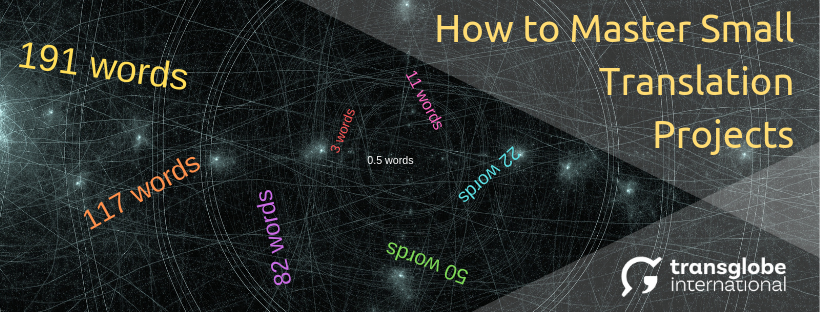One of the biggest challenges for LSPs is the matter of small translation projects. By small, we usually mean anything less than 250 words or about 1 page. These are very important projects, not less than the larger ones, as they represent small pieces of text that need to be updated regularly, sometimes even daily. Here we explore why these small projects can be harder to manage than larger projects, and how to master them.
Time pressure
Of course, “small” should mean “fast” – at least this is what the majority of people think. After all, several words, a few sentences or 1 small paragraph can be translated within minutes. At least in theory. The important thing to understand here is that each localization project requires a certain amount of time before and after the translation is completed. The project managers have to follow the same workflow for all tasks regardless of their size. The time to find an available and suitable translator and editor, assign the project, send all materials, negotiate a deadline and follow through the entire process. For the linguists there are instructions, guidelines and glossaries to read and follow, automatic checks to run and reports to deliver. And all these steps require time that is usually more than the time needed to simply translate the text.
Resource availability
In the localization industry timing is crucial. There is an optimal time to start a translation project, and an optimal time to complete it. With hundreds of different projects each day, the planning and execution of each one is calculated to the minute. And because of this small translation projects are the hardest to manage. They require higher availability at any given moment than bigger tasks, as their time window is usually pretty narrow. Basically, from the moment the task is received, time starts ticking and you need to act now.
Quality requirements
Another consequence of the small size of these tasks is that the quality expectations are much higher. No problems here, sure. Oftentimes short texts are more visible, e.g. marketing messages, ads, product page titles and descriptions, etc. And with higher visibility come the higher quality requirements. It takes a lot of focus to translate small translation projects, as there is no time for the translators to “warm-up” and reach their optimal tempo. So they read, re-read, check and re-check, before confirming final quality. Because 1 typo or omitted comma in 20 words is far worse than the same in 2000 words.
Context ambiguities
When translating a full-sized completed text, you can easily understand and follow the context. All sentences and paragraphs are connected and you can even resolve small ambiguities in the meaning if the context is clear enough. However, short texts can sometimes lack enough context to allow normal translation speed. This can even mean sending queries about a 50 word task, waiting for the Client to reply, and wasting even more time.
Pricing policies
As a standard, in the localization industry we normally charge per word. And the more words a Client sends, the higher the chance for volume-based discounts. This is quite expected and is a practice in almost any industry. On the other side, lower-volume translations below 250 words are considered small and require a minimum fee or charge to process. Usually this is a flat rate or is paid per hour and varies from half an hour to an hour. And here comes the most common issue – paying a minimum charge seems like paying a premium rate. And it’s never easy to explain to the Client why they should pay more for less.
The solution?
Okay, so how do LSPs deal with all these difficulties? Here are several tips to consider:
- Set a Minimum fee for small tasks if you still haven’t. Start from 250 words and go down if needed.
- Be flexible. Negotiate terms which are acceptable for you and your Client. Usually the minimum fee is between 0.5 and 1 linguistic hour, but you can charge whatever you agree on. For example, you can set a flat rate or charge 10 / 15 / 20 minutes.
- Explain your working process to your Clients so they understand how much time you need, why you need it and what’s their benefit.
- Find linguists who are available during business hours and are willing to undertake small tasks with short turnaround times. This is much trickier with freelancers, so the easiest way to ensure availability for small tasks is by hiring in-house linguists.
- Automate! Having a Client Portal could save you time and money, and will provide your Clients with an easy way to send you small tasks. All this without the need of exchanging multiple emails, confirming terms, preparing quotations, etc. Furthermore, your linguists will be able to translate faster and automate all translation checks.
- Don’t compromise with quality! If a Client won’t agree to pay a minimum fee, you might be tempted to save costs by using more inexperienced translators, or by skipping some checks. Don’t! This could be very damaging for your business, as we already saw above. Small tasks have higher quality requirements and are the easiest and fastest way to lose a Client.
The matter with small translation projects is not an easy one to master. It takes time and experience, it requires negotiation skills, meticulous planning, a keen eye for details and a swift execution. They can be annoying, time-wasting and nerve-racking, but also very rewarding in the long term. Your attitude towards small projects shows your Clients that you take any task seriously and inspires trust in them.
For localization projects of any size don’t hesitate to get in touch with us at hello@transglobeinternational.com, or by requesting a quote!


Trackbacks/Pingbacks